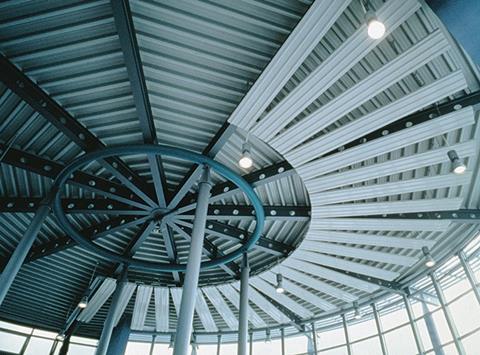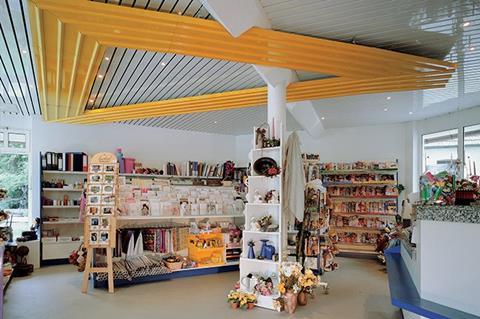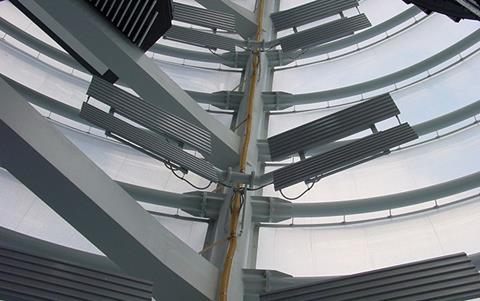Radiant panels can be used as an alternative to traditional convectors to heat and cool buildings. This module, sponsored by Zehnder, examines their benefits, design considerations and most common applications

How to take this module
UBM’s CPD distance-learning programme is open to anyone seeking to develop their knowledge and skills. Each module also offers members of professional institutions an opportunity to earn between 30 and 90 minutes of credits towards their annual CPD requirement.
This article is accredited by the CPD Certification Service. To earn CPD credits, read the article and then click the link below to complete your details and answer the questions. You will receive your results instantly, and if all the questions are correctly answered, you will be able to download your CPD certificate straight away.
CPD CREDITS: 60 MINUTES
DEADLINE: 21 NOVEMBER 2014
![]()
INTRODUCTION TO RADIANT HEAT
Radiant heat is a form of electromagnetic radiation, falling between ultra-violet and infra-red on the electromagnetic spectrum. Though it is invisible to the human eye, it shares the characteristics of light. As such it penetrates through the air without energy loss or deterioration, exchanging heat with any object of lower temperature by shining on it. The way that the sun heats the earth is an example of radiant heating.
The distinction between radiant temperature and ambient air temperature can be illustrated by the example of skiers sunbathing in the Alps. Even though the air temperature is below zero and they must wear insulated clothing for protection from the cold, the sun warms them directly and can quickly burn unprotected skin.
Such an extreme temperature difference is not a viable solution for heating spaces within a building. But radiant heat can be used to improve a room’s comfort levels. The “resultant temperature” of a room is an average of the radiant and ambient values - therefore an increase in radiant heat can be used to warm the occupants while keeping air temperatures lower (see below).
This CPD will examine how radiant heating panels work, their benefits and applications, as well as their ability to provide passive cooling.

HOW RADIANT PANELS WORK
Radiant panels are usually mounted on the ceiling or on high walls and provide an evenly distributed warmth to the room by shining heat on the objects below. As these objects are at a lower temperature, they absorb the heat and conduct it, increasing in temperature. These objects in turn become low temperature radiators, giving off lower levels of radiant heat and slowly warming the air within the room by convection.
There are many different radiant heat panels available and different manufacturers will use subtly different methods. However the basic concept in all cases is the same. Essentially, water is distributed throughout the metal panel via a tube, designed to provide the maximum surface area and therefore thermal contact. The water heats the tube, and the tube heats the panel.
It is impossible to achieve a surface temperature equal to the mean water temperature because there will always be some element of loss. In practice, a drop of 8-10°C is the norm. A panel’s output may vary from 400W/m2 to 600W/m2 at UK standard temperatures.
BENEFITS OF RADIANT HEATING
There are three key benefits when using radiant heating within a building: the optimisation of wall space, lower air temperatures and reduced convection. These can help save energy and money while creating a more comfortable environment for occupants.
Optimisation of wall space
With the installation of ceiling-mounted radiant heating panels, perimeter walls and floor space can be left free for equipment or furniture, ensuring the largest possible usable area. In addition, eliminating the need for surface temperature radiators at ground level creates a safer environment, and reduces the risk of accidental or deliberate damage. Services can be run through the ceiling void and do not need to be dropped down to a lower level, so installation costs are also reduced.
Lower air temperatures
As previously mentioned, high radiant values contribute to a higher resultant temperature in a room. The air temperature within a radiant heated room can therefore be up to 3°C lower than in a room heated by alternative means.
For example, if a radiator is installed in a room and provides an air temperature of 21°C and a radiant value of 17°C, it gives a resultant temperature of 19°C. If the radiator is replaced with a radiant panel, the air temperature can be lowered to 16°C and the radiant value increased to 22°C to achieve the same resultant temperature. By avoiding the need to heat all of the air within a room, radiant heating systems can offer considerable energy savings.
Reduced convection
One of the problems in understanding radiant heating is that we use the word “radiator” for an object that is primarily a convector. Radiators generally distribute 80% of their output via convection and only 20% via radiant heating. This means that, for a radiator to heat a room on a cold winter’s day, it must first warm itself and then the air around it. The air will move around the room by convection until the room is at a homogenous temperature. By standing close to the radiator, a person can take comfort from the 20% radiant heat available once the panel has reached its operational temperature. So if the radiator has an output of 1kW, 200W provides instant comfort, while 800W is being used to increase the air temperature.
However, if you take the radiator, remove the convectors from the back, insulate it and install it in a ceiling, you would be converting it into a radiant panel, and the output ratios would change to 70% radiant heat and 30% convection. With a 1kW radiant panel, 700W would be available as soon as the panel reached its operational temperature. This leads to efficiency savings - for example, a radiator system in a school may need to be switched on two or three hours before the occupants arrive, whereas a radiant heating system would only need to be switched on half an hour in advance.
Reduced convection also means lower dust levels, which is beneficial for allergy sufferers, and helps save on cleaning and maintenance costs.

DESIGN CONSIDERATIONS
The performance of radiant heating systems will vary according to number of factors, including the height of the installation, the distribution of the panels and the size of the tube within the panel.
Mounting height
The positioning of panels is a key consideration for ensuring that the heat produced will spread evenly throughout the space. The field of spread from a radiant panel is approximately a ratio of 2:1 to its mounting height. For example, a panel mounted at 3m will provide a radiant field of 6m. A mounting height of 5m will provide a radiant field of 10m. Therefore as the mounting height is increased, the intensity of the heat is reduced and the output is spread over a greater area.
The larger the output area, the greater the heat-load requirement. For installations up to 10m in height, there is no need to increase the panel output as radiant heat passes through the air without any loss. For installations between 10m and 15m, the relevant British standard, BS EN 12831, Heating systems in buildings, recommends a 15% increase in output to compensate for lower intensity levels.
Position of radiant panels
Within the radiant field itself, there will also be varying levels of intensity. The area directly under the centre of the panel receives an output level of between 90-100%, while the edge of the radiant field (equivalent to the height of the room multiplied by 1.5) will receive 50 % of the output. These calculations are particularly important when positioning panels in relation to objects within the room, such as directly over a patient’s bed in a hospital.
Rooms larger than 3.5m2 will require more than one panel. It is good practice to provide an even spread and an overlap of intensity above head height. In order to achieve this, the distance between the panels should not be greater than the mounting height. Within large spaces, specifiers may need to consider panels in two directions.
Mass flow rate
Specifiers can greatly reduce both the water and energy consumption of a heating system by choosing a product with the correct flow rate. The flow rate must be sufficient to produce turbulent conditions within the panel, or about 15% of the panel’s output will be lost.
The minimum flow rate depends on the pipe size. For example, a panel with a 15mm pipe coil at a flow and return temperature of 80˚C and 60˚C must be 3m long to create sufficient turbulence for a room temperature of 20˚C. Any panel shorter than this will not perform to its full potential unless the mass flow is increased. With a 10mm internal loop, sufficient turbulence is produced at a length of 1.8m, so only panels shorter than this require an increased flow rate.
Panels also have a maximum mass flow rate. If this is reached, they can become noisy and suffer excessive wear.
Aesthetics
Designers have considerable freedom to create bespoke radiant heating systems. Rafts, foils, freehanging units, non-standard shapes and a variety of colours can all be used to create striking aesthetics in applications from low-ceilinged offices to triple-height production halls (see examples illustrating this module).

RELEVANT STANDARDS
There is only one specification applicable to testing the output of a radiant panel: BS EN 14037. There is only one test chamber in Europe certified to conduct this testing, at the University of Stuttgart, in Germany. The test is conducted on a panel that is 3m long and 600mm wide, in a free-hanging/open ceiling position.
Any manufacturer that has tested its product will be able to supply specifiers with a BS EN 14037 certificate from the University of Stuttgart stating the output of a 3m x 600mm panel. This requirement should form part of any specification to ensure the correct heat outputs are obtained. Manufacturers using the BS EN 442 radiator test output will be reporting an incorrect output figure.
APPLICATIONS OF RADIANT PANELS
Radiant heating systems can be used in a wide variety of environments.
Offices, schools and hospitals
These are all environments that benefit from radiant panels’ ability to evenly distribute heat and quick response times. When installing radiant panels in rooms with low ceilings, careful design is required to avoid uncomfortable extremes of temperature. The specification of a single panel with a large output will create areas of high temperatures and an uneven distribution of heat. The lower the intensity and the more even the distribution, using a number of panels, the more comfortable the environment will be.
Warehouses, production halls and other large facilities
Most of the design considerations associated with low ceilings disappear when using radiant panels in large spaces. Large, high spaces offer the opportunity to increase the system temperature and obtain more output per square metre from the panels. Also, due to the larger heat load, there will be a number of panels and therefore an even distribution.
The bigger the space, the greater the cost-effectiveness of radiant systems compared with convective systems. This is because convectors must warm the whole air mass to achieve a comfortable temperature. When heating a large building such as a church, it may be possible to offer a 40% energy saving with a radiant system.
Radiant panels offer specific advantages for different types of large facility. For factories and production halls, which may have high numbers of employees, a convective system would struggle to maintain temperatures at low level as the warmer air rises. This would result in different temperature conditions for people working at different heights within the building. Likewise, for warehouses, the rising hot air could damage products stored at a high level.
For sports halls, meanwhile, the lack of air movement in a room heated by radiant panels is especially useful for games that rely on still conditions, such as badminton.
RADIANT COOLING
Radiant panels resting idle in the summer can be used to provide cost-effective cooling or partial cooling. For example, the radiant panels for a typical sports hall, providing 40kW of heating, could also provide 16kW of cooling. Radiant cooling is a passive approach: the radiant panel itself is the coolest item in the room and as the warmer items create convection the warmer air rises. This air then passes over the surface of the panel and cools down. It becomes heavier and drops back to the lower level, thus aiding natural convection and enhancing the cooling effect.
Radiant cooling is clean, silent, responds quickly, and also offers savings on installation, maintenance and running costs in comparison to other systems. When using radiant panels for heating and cooling, it is important to consider their use from the outset as part of the building’s indoor climate strategy. If the cooling function is to be used, separate controls and dew point sensors will be required and the pipework design will need to be based on the cooling requirements.


How to take this module
UBM’s CPD distance-learning programme is open to anyone seeking to develop their knowledge and skills. Each module also offers members of professional institutions an opportunity to earn between 30 and 90 minutes of credits towards their annual CPD requirement.
This article is accredited by the CPD Certification Service. To earn CPD credits, read the article and then click the link below to complete your details and answer the questions. You will receive your results instantly, and if all the questions are correctly answered, you will be able to download your CPD certificate straight away.
CPD CREDITS: 60 MINUTES
DEADLINE: 21 NOVEMBER 2014.
Privacy policy
Information you supply to UBM Information Ltd may be used for publication and also to provide you with information about our products or services in the form of direct marketing by email, telephone, fax or post. Information may also be made available to third parties. UBM Information Ltd may send updates about Building CPD and other relevant UBM products and services. By providing your email address you consent to being contacted by email by UBM Information Ltd or other third parties. If at any time you no longer wish to receive anything from UBM Information Ltd or to have your data made available to third parties, contact the Data Protection Coordinator, UBM Information Ltd, FREEPOST LON 15637, Tonbridge, TN9 1BR, Freephone 0800 279 0357 or email ubmidpa@ubm.com. View our full privacy policy at www.building.co.uk/cpd





























1 Readers' comment